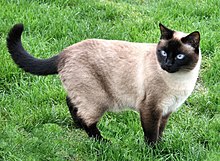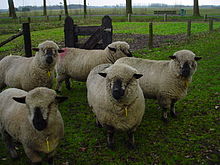Point coloration

Point coloration is
In cats

Point coloration in cats originated in the
As the expression of the gene responsible for the pointed pattern is regulated by temperature, pointed cats who live in cooler environments often show increased darkening of their fur relative to cats who live in warmer climates, sometimes even developing large dark areas along their sides.
Because of the pigment restriction caused by the temperature sensitive tyrosinase, pointed cats' eyes are always shades of blue because the blue layer in the eye common to all cats is not covered by another color. The back of the eye also lacks pigment, giving colorpoint cats' pupils an eerie red and silver reflection in the dark, unlike a normally pigmented cat's shining silver-green or -blue.
The point gene allele is at the C locus, where pure albinism is also carried, and is written as cs. Point is recessive, so two copies of cs, one from each parent, are needed for points to be expressed. Also carried on the C locus is the gene for the sepia pattern, which allele is represented by cb. This is the darkest of all of the pigment restricting patterns—pigment is only paled at the warmest point in the body: the abdomen. Sepia cats have amber-yellow to green eyes. When a cat carries the genes cs and cb, the intermediate mink pattern is formed, in which the pigment distribution is between sepia and point. The eye color of mink cats is on the blue-green spectrum (aquamarine).
- Comparison of different black (seal, sable) colourpoint cats
-
Black point Siamese
-
Black mink Tonkinese
-
Black sepia Burmese
-
Black tortoiseshell point cat
The lynx point pattern is formed by mating a colorpoint cat with a tabby cat (or breeding cats that already possess the lynx point pattern). It is characterized by a mixture of the darkening (reduced) of point coloration with distinct tabby striping on the head, tail, and legs, and an otherwise uniform and comparatively pale body. It is an accepted pattern in some cat registries, but not others, for particular breeds (mostly Siamese-related).
Point coloration is inherent to the Siamese breed and some other closely related breeds but with most other breeds the colorpoints (including lynx) were brought into some breed lines long after their establishment, but there are exceptions. For example, lynx point was a feature of some of the foundation stock of the Siberian, now called the Neva Masquerade.[2]
Cat breeds
- Balinese
- Birman
- British Shorthair
- Burmese
- Colorpoint Shorthair
- Highlander
- Himalayan
- Javanese
- Napoleon
- Neva Masquerade
- Peterbald
- Ragamuffin
- Ragdoll
- Siamese
- Snow Bengal
- Snowshoe
- Sphynx
- Thai
- Tonkinese
In dogs
This section needs expansion. You can help by adding to it. (March 2021) |
Tan points on dogs includes point coloration on a black or dark base coat with tan cheek spots, eyebrows, feet, forelegs and tail vent.[3] Typical tan point breeds include Dobermann and Rottweiler.[4]
Rarely, dogs may also have a point coloration similar to that of Siamese cats.[5]
In horses

In horses, point coloration is most often produced by the action of the
Other genes
Point coloration may also be visible on horses with other dilution genes that act upon a bay base coat. These include:
- The perlino, and some individuals may have slightly redder hair at the traditional point coloration locations.
- The Champagne gene, which on a bay base produces Amber Champagne.
A dilution gene that produces what looks like point coloration, but from a completely different genetic mechanism is the
Similarly, darker coloration at the points is also preserved in horses with the roan gene, a patterning gene, producing a body coat of mingled white and dark hairs, but leaving the points the darker base color in all horses, not just those carrying agouti.
Most other genes that produce spotting patterns or
-
White markings may partially or completely mask point coloration in horses
-
The dun gene leaves the points darker on all base coat colors, not just when agouti is present
-
The roan pattern allows point coloration to show on the head as well as traditional point locations
In rabbits and rodents

All pointed white rabbits of true breeding have red eyes.[6] The pointed white rabbit is created with the ch gene.[7] Its presentation is typified in the Himalayan rabbit breed (the first rabbit breed with a pointed white coat) and in the Californian breed.
Rabbit coat colors
Some rabbits that appear to be pointed white lack the red eyes, which indicates they are of different breeding. The following such coat colors are examples of those created, not with the ch gene, but with the cchl, cchd, or cchm gene in conjunction with the e gene:[citation needed]
- Blue point
- Chocolate point
- Lilac point
- Pearl
- Sable point
- Sallander
- Seal point
- Siamese
No pointed white rabbit can produce orange pigment; therefore, the points are always either black, blue, chocolate, or lilac.[citation needed] The resulting point coloration is sometimes in conjunction with a coat pattern, such as: white agouti, marten, broken, Vienna, or harlequin. (Such coats may not be recognized for showing.)
Rabbit breeds
Breeds of rabbit that include varieties with point coloration include:[8][9]
- Altex
- American Fuzzy Lop
- English Angora
- French Angora
- Californian
- Cashmere Lop
- Himalayan
- Holland Lop
- Jersey Wooly
- Lionhead
- Mini Lop
- Mini Rex
- Mini Satin(in development)
- Netherland Dwarf
- Pointed Beveren
- Rex
- Satin
- Satin Angora
In fancy (domestic) rats
The C - Albino locus gene causes dilution of yellow and black coloration, causing Himalayan or Siamese markings depending on the allele is affected.
Point colors in rats include:
- Sepia
- Seal Point
- Blue Point[10]
In guinea pigs
There is only one type of guinea pig with a pointed coat. It is called the
In sheep

Some breeds of sheep exhibit point coloration.
Sheep breeds
- Clun Forest
- Dorset Down
- Hampshire
- Norfolk Horn
- Oxford
- Shropshire
- Suffolk
- Tunis
- Valais Blacknose
- Wensleydale
References
- PMID 16573534.
- ^ TICA. "Siberian Introduction" (PDF).
- ^ "GLOSSARY OF TERMS Used in Relation to Dog Coat Colours and Patterns". www.lowchensaustralia.com. Chinaroad Lowchens of Australia. Retrieved 11 December 2018.
- ^ "Dog Coat Colour Genetics". www.doggenetics.co.uk. Retrieved 11 December 2018.
- S2CID 222302410.
- ^ "Himalayan rabbit", Wikipedia, 2020-01-14, retrieved 2020-09-02
- ^ "Rabbit Color Genetics: Self Chinchilla Explained – Rabbit Smarties : Creative Resources for Rabbit Keepers". 19 July 2011. Retrieved 2020-09-02.
- ASIN B018GVBJK4.
- ^ "Breed Standards 2016-2020" (PDF). British Rabbit Council. Archived from the original (PDF) on 21 January 2018. Retrieved 11 February 2018.
- ^ "AFRMA - Rat Genetics, part 1".








